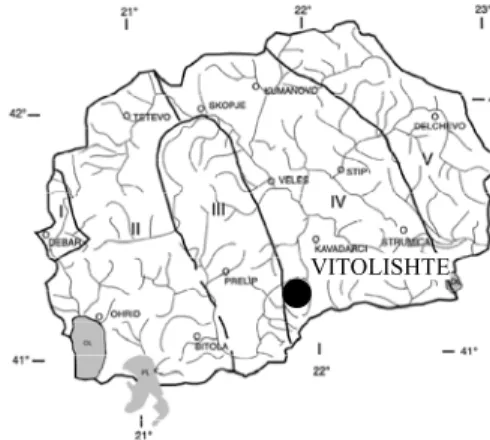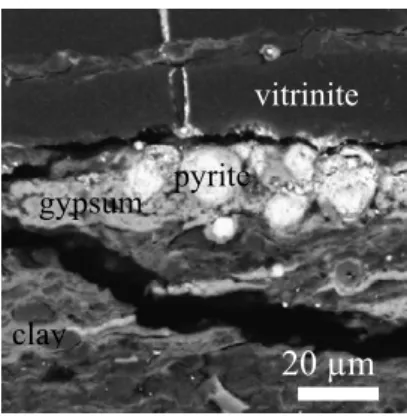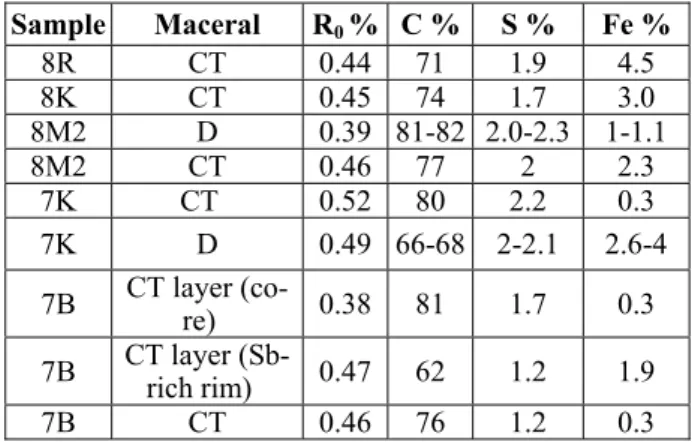HAL Id: insu-00156309
https://hal-insu.archives-ouvertes.fr/insu-00156309
Submitted on 29 Jun 2007
HAL is a multi-disciplinary open access archive for the deposit and dissemination of sci-entific research documents, whether they are pub-lished or not. The documents may come from teaching and research institutions in France or abroad, or from public or private research centers.
L’archive ouverte pluridisciplinaire HAL, est destinée au dépôt et à la diffusion de documents scientifiques de niveau recherche, publiés ou non, émanant des établissements d’enseignement et de recherche français ou étrangers, des laboratoires publics ou privés.
Characterization of coal from the Mariovo basin,
Macedonia – Insights from organic geochemical and
sulphur isotopic data
Catherine Lerouge, Jérôme Gouin, Yves Deschamps, Fatima Laggoun-Défarge,
G. Tasev, T. Serafimovski, M.G. Yossifova
To cite this version:
Catherine Lerouge, Jérôme Gouin, Yves Deschamps, Fatima Laggoun-Défarge, G. Tasev, et al.. Char-acterization of coal from the Mariovo basin, Macedonia – Insights from organic geochemical and sul-phur isotopic data. Mineral Exploration and Reseach: Digging Deeper, Aug 2007, Dublin, Germany. 4 p. �insu-00156309�
Characterization of coal from the Mariovo basin, Macedonia –
Insights from organic geochemical and sulphur isotopic data.
C. Lerouge, J. Gouin1,2, Y. Deschamps, D. Widory2 BRGM, BP 36009, 45060 Orleans Cedex 2, France
1 ISTO- CNRS-University of Orleans, UMR 6113, BP 6759, 45067 Orleans cedex 2, France
F. Laggoun-Defarge
ISTO- CNRS-University of Orleans, UMR 6113, BP 6759, 45067 Orleans cedex 2, France
G. Tasev, T. Serafimovski
University “St. Cyril and Methodius” Skopje, Faculty of Mining and Geology, Goce Delcev 89, 92000 Stip, Macedonia
M.G. Yossifova
Geological Institute, Bulgarian Academy of Sciences Acad. G. Boncev St., Bl. 24, 1113 Sofia, Bulgaria
ABSTRACT: data detailed petrographic study of coal from the Mariovo basin in Macedonia sug-gests circulation of fluids mobilizing metals from different origins (basement, volcanism ?) during burial. Sulphur isotopic data on organic matter and pyrite indicate dominantly marine-derive fluids and processus of bacterial reduction of sulphates.
KEYWORDS: Coal chemistry, organic sulphur, metals, vitrinite reflectance, electron microprobe, Mariovo basin, Macedonia,.
1 INTRODUCTION
Coal in Macedonia is the main energetic re-source for electricity production. The Mariovo basin is located in the southwest part of Mace-donia, 46 km away from the town Prilep. The basin is constrained within Mt. Selecka, be-tween the villages Vitoliste, Polciste, Besiste and Manastir, with the topography, and be-tween 700 and 1000 m above sea level. The ex-ploration was developed with intention towards the prospecting of the coal potential of the ba-sin. The productive coal formation is developed in the eastern and the western parts of the basin. Excluding the most outer parts of the deposit, the productive formation occurs as a main layer of coal, which has sub-horizontal position with variable thickness (between 1.3 and 14.9 m) and a relative depth of appearing between 7.7 and 279 m. The coal from Mariovo basin is rep-resented by lignite with high percentage of ash. The total reserves of coal in the deposit "Mariovo" are around 111 Mt. Informations about the contents, distribution and origin of sulphur and metals are important in coal com-bustion, because of their consequence on the production and on environment. Few detailed studies have been realized on coals from Mace-donia. This work presents new petrographic, chemical and sulphur isotope data on coal, to
better characterize organic matter and constrain the deposition conditions.
2 GEOLOGICAL SETTING
Macedonia lies within the Cenozoic Southern Balkan Extensional regime (Dumudzanov et
al., 2004). The Mariovo graben is located in
central and southern Macedonia, along the boundary between the Vardar zone and Pelago-nian Massif.
Figure 1: Major tectonic units of Macedonia. I. Chukali-Krasta zone; II. Western Macedonian zone ; III. Pelagonian anticlinorium ; IV. Varar zone; V. Serbo-Macedonian mas-sif.
Most of the basinal infilling has been eroded, one of the best preserved outcrops being close to the village of Vitolishte. The sediments of the graben are divided into four formations from the bottom to the top:
- The Nerezi formation (NeF) is divided into 3 units. The basal unit of ~120 m essentially consists of gravels and sandstones of unknown age. The middle unit consists of ~70 m of silt-stones and silty claysilt-stones that grade upward into coal and claystones and finally into a 6-15 m thick layer of coal overlaid by marls and claystones. The latter contain planktonic algae association of late Miocene age (Dumudzanov et al. 2004). The upper unit consists of ~60 m of siltstones and sandstones followed by a break of sedimentation.
- The Solnje formation (SoF) consists of ~60-80 m of gravel and sandstones of Pliocene age.
- The Vitacevo formation (ViF) of Pliocene age (Dumudzanov et al. 2004) begin with strati-fied tuffs overlain by sandstones and gravels, interbedded with diatomite, tuffs and sandy claystones. Above travertine layers are de-posed, followed by 80 m of tuff and sandstones.
- At the top is the Mariovo formation (MaF). It is ~60-70 m thick and contains pyroclastic rocks with nine travertine layers and a 20 m thick travertine deposit covering 20 km2, indi-cating a lacustrine environment.
3 SAMPLING
Samples of coal seams and intercalated sedi-ments were collected on three outcrops around the Vitolishte village (∼ 21°49.6 E, 41°10.8 N). The first sample (7B) is from a small outcrop close to the river. The second sample (7K) is from a small outcrop around twenty meters above the river. The coal seam is not more than 50 cm thick with an intercalated siltite layer. The sample 7K is a coal from the upper part of the seam, which also contains vitrinite lenses. The third outcrop (samples 8K, 8M and 8R) is located on the opposite side of the river, at the same level as the second outcrop. It is the most important one, with two coal seams separated by a 15 cm thick layer of siltite containing floated wood fragments. The lower coal seam is 150 cm thick (8M, 8R) and the upper one is 50-70 cm thick (8L). The sediments overlying the coal formation consist of an alternation of hard mica-rich sandstones, soft layers and clay-stones. The coals are generally of black coal type. Samples 7B and 7K are composed domi-nantly of clarain with lenses of vitrain, whereas samples 8K, M and R are richer in vitrain.
4 ANALYTICAL METHODS
Samples were observed and analysed using a JEOL scattered electron microscope equipped with an EDS detector. Local analyses of or-ganic matter were performed using a Camebax SX50 electron microprobe with a two stages analytical program. At the first stage C, Si and P are analyzed with a 10 kV acceleration volt-age, a current beam of 20 nA and a 4-5 µm beam width. At the second stage Zn, S, Fe, As, Co, Ni, U, V, Ge, Sb, Cr, W are analyzed with a 20 kV acceleration voltage and a current beam of 20 nA. Matrix corrections were made with a ZAF computing program.
Vitrinite reflectance was measured on coal peaces in accordance with standard procedures (ISO 7404/5 1984).
Sulphur isotopes of sulphates and organic sulphur were performed using a CFIRMS sys-tem coupled with Flash EA and gas bench.
5 MINERALOGY
A variety of minerals is present in the coal of Vitolishte. The mineral composition is domi-nated by clays, rare quartz, pyrite, gypsum, iron oxides, and probably calcite. Detrital minerals are represented by clasts of quartz, and by nu-merous dispersed particles of clay minerals (il-lite/muscovite, illite, illite/smectite) within or-ganic matter. Pyrite is the major sulphide in the coal of Vitolishte. It is mainly observed as framboids and more rarely as euhedral crystals, occurring along stratified plans or infilling cavities of plant tissues. SEM analyses of pyrite zones show the presence of Si, Al and Ca that strongly suggests the initial co-precipitation of silica, clay mineral and a Ca-mineral (such as calcite) with pyrite.
Figure 2: Backscattered electron image of framboidal pyrite surrounded by secondary products of gypsum.
pyrite
vitrinite
20 µm clay
Gypsum is visible on the surface on the samples; it is one of the major constituent of the inorganic matter. In polished section, gypsum also occurs as fine layers or surrounding pyrite framboids (Figure 2). Gypsum closely con-nected with pyrite in most of the samples indi-cates that it is essentially a weathering product of pyrite. However the gypsum in fine layers associated with a calcium phase (calcite) could be due to the crystallization of calcium and sul-phate ions dissolved in the pore water during the sedimentation, according to Vassilev et al. (1994). Iron oxides are present as late infilling of fractures, strongly suggesting that they result from the weathering of pyrite. SEM analyses of pyrite zones and gypsum show the presence of Si and Ca and strongly suggest the initial co-precipitation of silica and a Ca-mineral such as calcite with pyrite.
6 PETROGRAPHY AND GEOCHEMISTRY OF COAL
The contents of sulphur, carbon and trace ele-ments in coal from Vitolishte are given in the table 1. Major elements are C, Si and Al, whereas minor elements are Ca, Fe, K, S and Ti. Coal from Vitolishte has low total sulphur content, consistent with low-sulphur coal ac-cording to Dai et al. (2002). Ash content is high and consistent with previous data. Metal con-tents in coals from Vitolishte are over the Clarke values for lignites and sub-bituminous coals (Yudovich et al., 1985) for As, Cr, Li, Pb, Sc, V and Zn. They are close to the Clarke val-ues or slightly above for Ba, Co, Cu and Ga.
EPMA analyses and reflectance measure-ments were realized on macerals to determine the distribution of sulphur and metals (table 2). Sulphur contents in macerals are high and rela-tively homogeneous, ranging from 1.2 to 2.3 wt%, whereas iron contents are low, showing that measured sulphur can be attributed to or-ganic matter. Maceral composition of samples 7B and 7K is rather heterogeneous and is com-posed of alternation of collotelinite layers with desmocollinite and associated fusinite. Collote-linite layers in 7B exhibit rims with higher re-flectance than core (Figure 2 and Table 2), and enriched in Si and Sb (280-750 ppm). SEM bulk analyses of collotelinite show homogene-ous contents of sulphur, calcium and Fe. Rare light-colored zones in backscattered electron image observed in the core of collotelinite
lay-ers are slightly enriched in calcium. Desmocol-linite and associated with fusinite in the sample 7B are V-rich (200-1160 ppm).
Table 1: Chemical composition of coal from Vitolishte, compared to Clarke content for lignite and subbitumi-nous coals (Yudovich et al. 1985).
Table 2: reflectance measurements and EPMA analyses of collotelinite (CT) and desmocollinite (D) for carbon, sulphur and iron.
Sample Clarke 7K/7E 8 (lower seam)
C tot % 41.4 (40.1) 36.6 (49.2) S tot % 1.0 (0.9) 0.8 (0.7) N tot % 0.9 1.0 IH (mgHC/gTOC) 126 IO (mg CO2/gTOC) 108 136 Ash yield 27 % 23 % Al2O3 % 5.8 4.5 CaO % < dl 1.3 Fe2O3 % 1.8 1.4 K2O % 0.7 0.6 MnO % 0.03 0.06 SiO2 % 13.1 9.9 TiO2 % 0.22 0.17 As ppm 7.4 23 25 Ba ppm 120 151 104 Ce ppm 59 42 26 Co ppm 4.2 8 5 Cr ppm 15 37 29 Cu ppm 14 11 7 Ga ppm 7 8 5.9 Ge ppm 1.5 0.4 0.2 Li ppm 20 26 20 Ni ppm 9 33 39 P ppm 220 639 425 Pb ppm 6.7 15 10 Sb ppm 0.82 < dl <dl Sc ppm 2 5.4 3.6 Sr ppm 130 70 73 U ppm 2.1 1.2 1.5 V ppm 22 27 24 Zn ppm 18 46 37 Sample Maceral R0 % C % S % Fe % 8R CT 0.44 71 1.9 4.5 8K CT 0.45 74 1.7 3.0 8M2 D 0.39 81-82 2.0-2.3 1-1.1 8M2 CT 0.46 77 2 2.3 7K CT 0.52 80 2.2 0.3 7K D 0.49 66-68 2-2.1 2.6-4 7B CT layer (co-re) 0.38 81 1.7 0.3 7B CT layer (Sb-rich rim) 0.47 62 1.2 1.9
Figure 2. Micrograph in reflected light of a collotelinite layer from the sample 7K, showing rims characterized by higher reflectance and high Si and Sb contents.
On other hand, samples 8K, 8M and 8R are mainly composed of collotelinite. Its reflec-tance values are comparable to that of samples 7. This range of values corresponds to that of sub-bituminous coals. However the carbon con-tent of some macerals seems to be high for this rank. Vitrinite from the sample 8K is character-ized by prismatic cracks, probably resulting from a thermal influence (M. Yossifova, pers. comm.). However, its reflectance remains rather low, and comparable to that of other samples. Collotelinite in the samples 8K, 8R and 8M are Ni-rich (260-700 ppm) and show important local Ge and Ga contents (up to 350 and 530 ppm, respectively). EPMA analyses of macerals from the coal of Vitolishte also pro-vide epro-vidence of local important contents of Co, Cu, Pb, Sb, Zn and W. The large variety of metals and their distribution in organic matter suggest circulation of fluids during burial, that mobilize metals from different sources (base-ment, volcanism ?).
7 SULPHUR ISOTOPES
Gypsum and organic sulphur was analyzed in different samples of Vitolishte. Gypsum which is the secondary product of pyrite weathering has preserved the ∂34S of the syn-sedimentary pyrite. ∂34S values of organic sulphur are +5.4 and +13.2 ‰. They are slightly higher than the classical range of organic sulphur signature in low-sulphur coals, which derive essentially from plants (+2 to +8 ‰; Dai et al. 2002). These data suggest that sulphur was not ac-counted only for original plants, but introduced into peat after burial. High positive ∂34S values of pyrite and organic sulphur could result from the bacterial reduction of additional
marine-derived sulphates evolving in a close system. The presence of planktonic algae in clay stones above the coal seam is consistent with an in-termittent marine environment.
Table 3: Sulphur isotopic composition of secondary sulphates and sulphur of organic matter.
8 CONCLUSION
New data on the coal from the Mariovo basin confirm the high ash content. Total sulphur content remains low and metal contents are slightly higher than the Clarke values of lignite and subbituminous coals. The detailed petro-graphic and isotopic studies of organic matter and framboidal pyrite provide evidence of a re-lation between macerales and V-Ni-Sb con-tents, and of bacterial reduction of sulphates, partly of external origin (marine-derived?). Fur-ther investigations need to be done to determine the origin of metals.
ACKNOWLEDGEMENTS
This work was financially supported by the ECO-NET program (10161XM) between the BRGM (France), the Geological Institute of Sofia, Bulgarian Academy of Sciences (Bul-garia) and the University of Skopje (Mace-donia).
REFERENCES
Dai S, Ren D, Shao L, Li S (2002) Distribution , isotopic and origin of sulfur in coals in the Wuda coalfield, Inner Mongolia, china; International Journal of Coal Geology 51: 237-250.
Dumudzanov N, Serafimovski T, Burchfiel BC (2004) Evolution of the Neogene-Pleistocene Basins of Ma-cedonia; Boulder, Colorado, Geological Society of America digital Map and chart series 1, 20 p.
Vassilev SV, Yossifova MG, Vassileva CG (1994) Min-eralogy and geochemistry of Bobov Dol coals, Bul-garia; International Journal of Coal Geology 26: 185-213.
Yudovich Y, Ketris M, Mertc A (1985) Trace elements in Coal. Nauka, Leningrad, 239 pp. (in Russian).
Sample Mineral phase δ34S
sulfate δ34Svitrinite
7K Gypsum +17.2
7K MgSO4 +14.9
8L Gypsum +17.3
8M vitrinite +5.4
8R Gypsum and vitrinite +8.5 +13.2
vitrinite Sb-Si rich vitrinite



